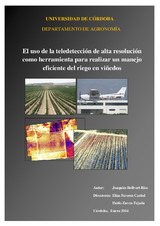El uso de la teledetección de alta resolución como herramienta para realizar un manejo eficiente del riego en viñedos
Autor
Bellvert, Joaquim
Director/es
Fereres Castiel, ElíasZarco-Tejada, Pablo J.
Editor
Universidad de Córdoba, Servicio de PublicacionesFecha
2014Materia
ViñedosTeledetección de alta resolución
Riego
Plant Cell Density (PCD)
Crop water Stress Index (CWSI)
Sensores aerotransportados de alta resolución
Estado hídrico
METS:
Mostrar el registro METSPREMIS:
Mostrar el registro PREMISMetadatos
Mostrar el registro completo del ítemResumen
The use of plant-based indicators for irrigation management has been widely studied.
However, the high number of measurements necessary to identify spatial variability in
orchards makes this system difficult to be carried out in large commercial areas. The
alternative may be the use of remote sensing. Development of high resolution airborne
sensors during the last years brings about new possibilities for detecting plant water status
remotely in large areas, and therefore to conduct a more efficient irrigation management
for water use.
The aim of this PhD thesis is the development of a tool for vineyard spatial variability
management, by using high resolution remote sensing imagery. To achieve it, two
methodologies to re-design irrigation sectors were firstly compared, with the goal of
reducing yield variability. Methods were based on using structural vegetative indices such
as Plant Cell Density (PCD) obtained from multispectral images, and leaf water potential
measurements (ΨL).
It is also presented the development of Crop Water Stress Index (CWSI) for the four
grapevine varieties Pinot-noir, Chardonnay, Syrah and Tempranillo, as a tool for quantify
vine water status with remote sensing thermal imagery. CWSI was empirically developed
with infrared temperature sensors to subsequently generate CWSI maps by acquiring high
resolution thermal images. CWSI was developed and validated with ΨL measurements at
different phenological stages.
Effectiveness aspects to consider such as the optimal moment of the day to detect vine
water status with aerial thermal images, the minimum spatial resolution required, or the
most appropriated aerial platform, were also studied in this PhD thesis. The
implementation of this technology in viticulture will permit to make a more efficient
irrigation management taking into account vineyard spatial variability. El uso de indicadores del estado hídrico de los cultivos para la optimización del riego en
cultivos leñosos ha sido ampliamente estudiado. Sin embargo, el elevado número de puntos
de medidas necesarios para caracterizar la variabilidad espacial de una parcela, hace que
sea un sistema de difícil aplicación en grandes extensiones comerciales. La alternativa se
basa en el uso de la teledetección. Con el desarrollo en los últimos años de sensores
aerotransportados de alta resolución, se abren nuevas posibilidades para detectar el estado
hídrico de los cultivos en grandes extensiones y poder realizar un manejo del riego más
eficiente.
Esta tesis doctoral tiene como principal objetivo desarrollar una herramienta que permita
manejar la variabilidad espacial de los viñedos, mediante la utilización de la teledetección
de alta resolución. Para tal fin, en primer lugar se han comparado dos metodologías para
re-definir los sectores de riego, con el objetivo de disminuir la variabilidad productiva. Los
métodos se basaron en el uso de índices estructurales de vegetación, tales como el Plant
Cell Density (PCD) obtenidos a partir de imágenes multiespectrales, y con medidas del
potencial hídrico de hoja (ΨL).
Se presenta también el desarrollo del Crop Water Stress Index (CWSI) en las cuatro
variedades de viña Pinot-noir, Chardonnay, Syrah y Tempranillo, como herramienta para
cuantificar el estado hídrico mediante la teledetección térmica. El CWSI se desarrolló
empíricamente con sensores de temperatura infrarrojo para posteriormente poder generar
mapas de CWSI mediante la adquisición de imágenes aéreas térmicas de alta resolución. El
CWSI se desarrolló y validó con medidas de ΨL en las distintas fases fenológicas.
Aspectos de operatividad, tales como el momento idóneo del día para detectar el estado
hídrico mediante imágenes aéreas térmicas, la resolución espacial mínima requerida, o la
plataforma aérea más adecuada, también han sido estudiados en esta tesis. La
implementación de esta tecnología en la viticultura permitirá realizar un manejo del riego
más eficiente teniendo en cuenta la variabilidad espacial del estado hídrico en un viñedo.

